When it comes to catching speeding motorists in the act, Salem’s was the first police department in the Pacific Northwest to use radar cars.[1] Radar technology came of age during the Second World War, although potential uses of the fact that radio waves bounce off of metal objects at measurable rates were recognized as early as 19th century.[2]
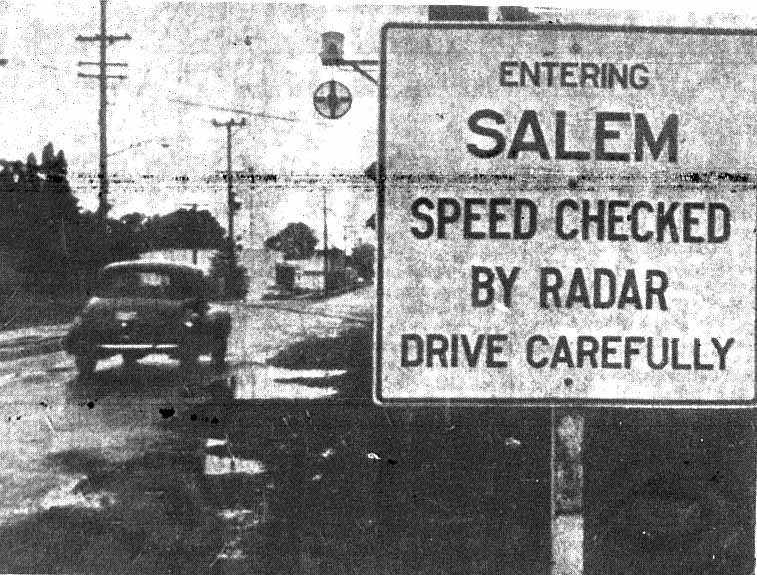
The introduction of radar cars on the Salem Police Force in 1953 necessitated the installation of these signs at all city entrance points. Photo Source: Capital Journal 6 Aug 1953, pg 5.
Radar on the Radar
Salem’s interest in radar for the purposes of catching and deterring speeders dates back to 1952, when Salem Police Chief Clyde A. Warren and Captain Glen Bowman invited a safety engineer from the Truck Insurance Exchange to demonstrate the system.[3] Using a “suitcase sized box and a dial” run entirely off of power the battery of the vehicle it was attached to, the engineer was able to show the speed of “every passing car – and even pedestrians and bicycles.” [4] The demonstration lasted about a half an hour and was set up on north Summer Street, where the department had received several complaints of excessive speed. Demonstrating the fallibility of human observation, the demonstration only documented 2 vehicles going above the speed limit, despite the complaints lodged.[5]
When concerns about speeding were brought up at the February 1953 Salem City Council Meeting, city manager J. L. Franzen was prepared. He reported to the alderman (name given councilors at the time) that for a $1000 the police department could outfit one radar car. The new system would not only help the police, but “have a desirable psychological effect on drivers.” The council approved the expenses for the radar equipment and warning signs that evening.[6]
Systems Go
By the summer of 1953, the radar equipment was ready for use and warning signs at all entry points to the city, which read “Entering Salem. Speed Checked by Radar. Drive Carefully,” were posted. After weeks of warnings, on August 6th the first official arrest of a speeding motorist was made.[7] Yes, you read that right, arrest. Roman Heine was clocked going 40 miles per hour in a 25-mile zone in the 2000 block of North Commercial Street, hurrying to get to a doctor’s appointment. The newspaper was quick to note Heine’s arrest would not have been the first had the equipment been set up only minutes earlier as the equipment charted a motorist going 54 mile an hour.[8] By the end of the first day 6 motorists were arrested for travelling more than 40 miles and hour in a 25 zone.[9]
As early adopters of the new technology, it was to Salem that the Portland Police Bureau looked to train their officers nine months later.[10]
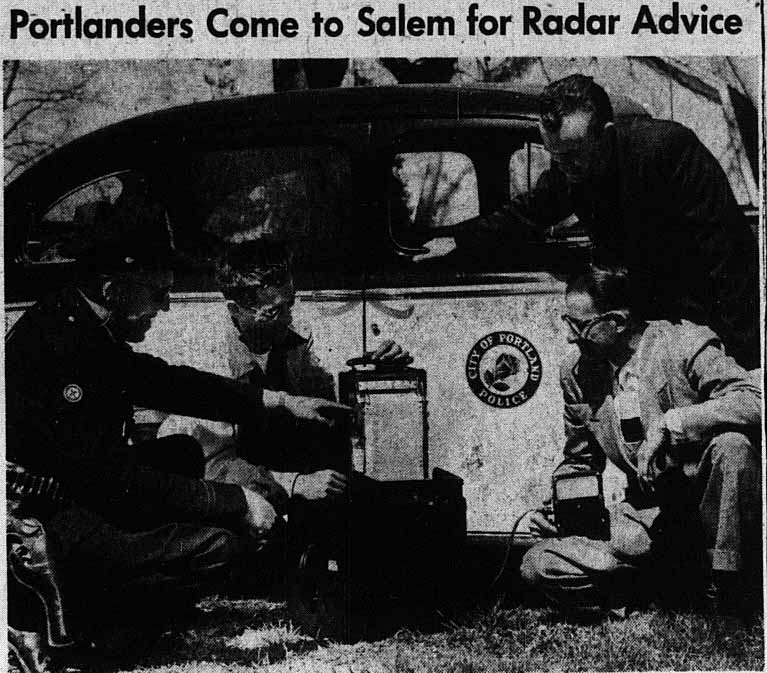
The Portland Police Bureau sent officers to train with the Salem Police Department in March 1954. Pictured here (left to right) are Salem patrolman Charles Creasy, Portland Police Officers C.H. Smith, Curt Carlson and Robert Granby. Photo Source: Oregon Statesman. 31 March 1954, pg 1.
The radar car was a good deterrent. The Capital Journal reported that average speed, accident and arrest rate lessened after the equipment was put into use.[11] In operation, the radar car was parked, and an officer would measure the speeds of motorists passing. The “chase car” was located a little further down the road and would listen for the first to identify any vehicles speeding past and then flag down the motorist. A record of all speeds was charted by the recording unit in the first vehicle.[12]
Drivers tried many ways to thwart the measuring device, but tin foil attached of a length to correspond with the wave length of the speedmeters didn’t jam receiver, it just allowed the meter to track the tin foil’s speed – which coincidentally was the same speed as the car.[13]
Legal Challenges
Although effective, the new technology was not without its legal challenges. Many thought that the device violated the state’s speed trap law passed by the legislature in 1935.[14] That was the defense used by the attorneys for Mrs. Franz in a trial before the Salem Municipal Court after her speeding arrest. According to the text of law, a speed trap was any physical section of road where the distance was measured, and a vehicle could be timed to indicate speed from one point to the next. The city maintained that since radar readings are instantaneous they did not fall under that definition.[15] During the trial, City Attorney Christ Kowitz explained the intent behind the 1930s legislation was to “prevent small towns from milking fines from unsuspecting motorists who drove through a measured section of road and found themselves arguing with a policeman holding a stopwatch.”[16] The issue would eventually be taken to the state legislature, which would finally pass a bill to make the use of radar equipment legal for monitoring motorists’ speed in April, 1955.[17]
Inglorious End of the First Radar Car
The original radar equipment and car met an inglorious end in a collision with an 18-ton, ready-mix cement truck just shy of its 5th anniversary with the force.[18] Radar car driver, Officer John Raymond Creasy, was seriously injured and spent three weeks in the hospital after the crash.[19] The radar car and receiver were not salvageable, but the recording unit was kept by the Salem Police Department and is on display through August 31, 2019 at the Willamette Heritage Center as part of the latest exhibit: CSI:SALEM – An Historical Look at Crime Fighting in Oregon’s Capital.
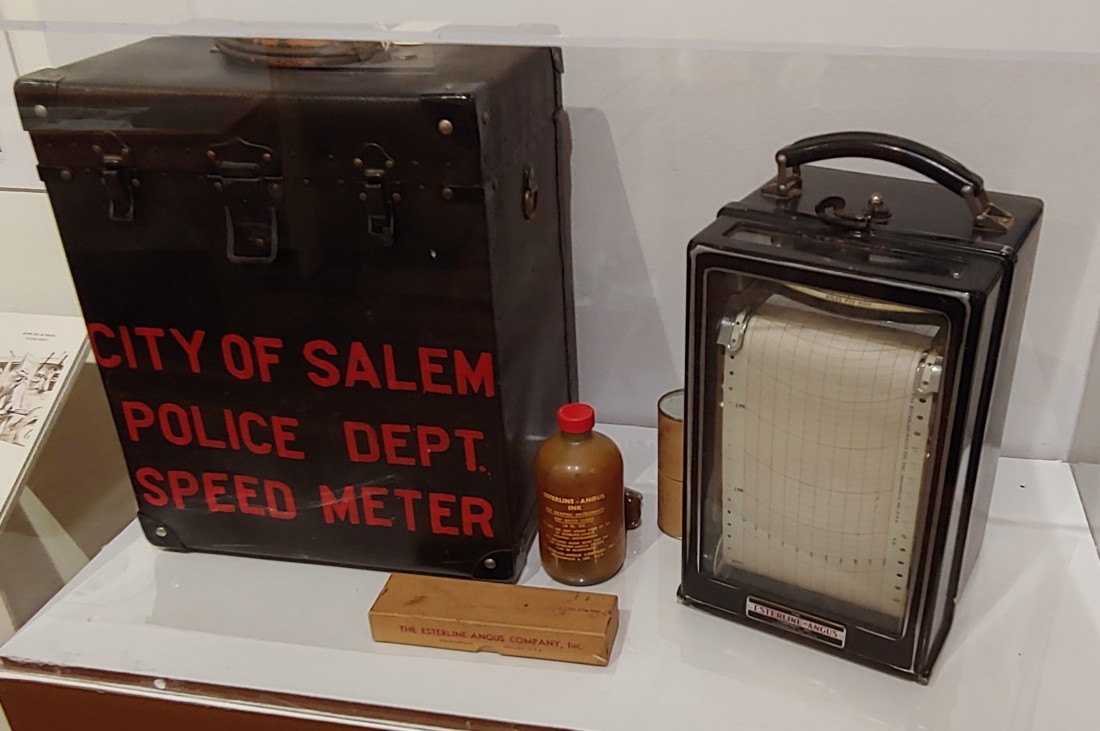
All that is left from original radar equipment is the recording box. The rest was destroyed in a crash in 1958. Item on loan from the City of Salem.
Sources
[1] “Radar Equipment Makes 75 Per Cent of All Speeding ‘Pinches’ in Salem.” Oregon Statesman 24 November 1957, pg 18.
[2] See: The History of Radar – Wikipedia
[3] “Electronic Gear Displayed for Traffic Police.” Oregon Statesman 26 Sept 1952, pg 6
[4] “Electronic Gear Displayed for Traffic Police.” Oregon Statesman 26 Sept 1952, pg 6
[5] “Electronic Gear Displayed for Traffic Police.” Oregon Statesman 26 Sept 1952, pg 6
[6] Stone, Stephen A. “Safety Predominates City Council Meeting” Capital Journal. 10 Feb 1953, pg 5.
[7] “You were warned.” Capital Journal. 6 Aug 1953, pg 5.
[8] Cromwell, Dave. “Radar Detection Now Followed by Arrests.” Capital Journal. 6 Aug 1953, pg 1.
[9] “Radar as Traffic Check Assured of Court Test; new Arrests Made.” Oregon Statesman 8 Aug 1953. Pg 1
[10] “Portlanders Come to Salem for Radar Advice.” Oregon Statesman 31 Mar 1954, pg 1
[11] “Salem Radar.” Capital Journal. 6 Aug 1953 pg 5
[12] Morrsion, Allen. “Radar Equipment Makes 75 per cent of all speeding ‘pinches’ in Salem.” Oregon Statesman 24 Nov 1957, pg 18
[13] Morrsion, Allen. “Radar Equipment Makes 75 per cent of all speeding ‘pinches’ in Salem.” Oregon Statesman 24 Nov 1957, pg 18
[14] Olson, James D. “Legality of Use of Radar for Speeders Question.” Capital Journal. 22 Jun 1953, pg 1.
[15] Radar as Traffic Check Assured of Court Test; New Arrests Made” Oregon Statesman 8 Aug 1953, pg 1. “Radar Arrest Rule Now up to City Judge.” Oregon Statesman 10 Oct 1953, pg 1. “Technical Jargon Marks First Challenge for Radar. “ Oregon Statesman 10 Oct 1953, pg 5.
[16] “Technical Jargon Marks First Challenge for Radar” Oregon Statesman. 10 Oct 1953, pg 5.
[17] Passes Senate Feburary 1955 (see “Senate Votes to Legalize Use Radar on Cars.” Capital Journal 7 Feb 1955, pg 1). Passes House April 1955 (see Olson, James D. “Hatfield Recording Presented by Ohmart.”Capital Journal 16 Apr 1955 pg 6 “when the bill finally passed the House.” And “Bill Clarifying Radar Law kept Alive at Salem.” Bend Bulletin 24 Mar 1955, pg 16.
[18] Stevens, Robert L. “Officer Seriously Hurt in Collision.” Oregon Statesman. 1 April 1958, pg 1.”Salem Officer ‘Fair’ After Truck Smash.” Capital Journal. 31March 1958, pg 1.
[19] “Truth will Out.” Capital Journal. 29 April 1958, pg 9.
This article was originally written for the Statesman Journal and published Sunday, July 7, 2019. It is reproduced here with citations for reference purposes.



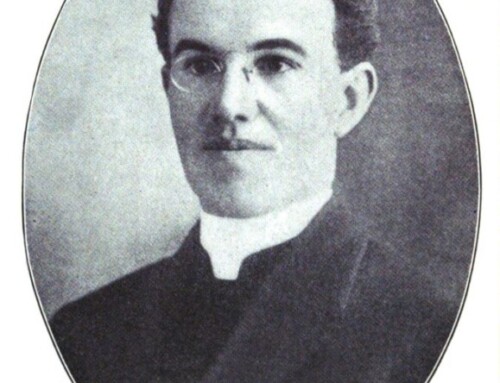
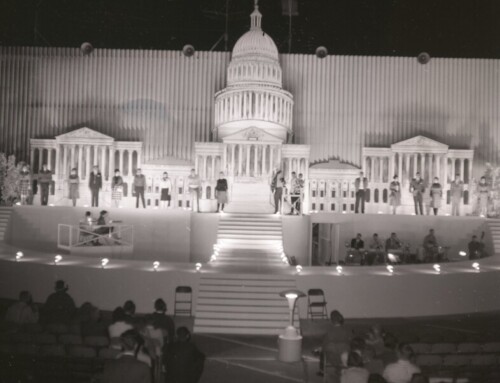
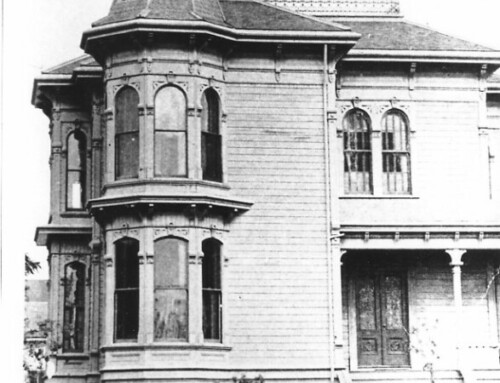
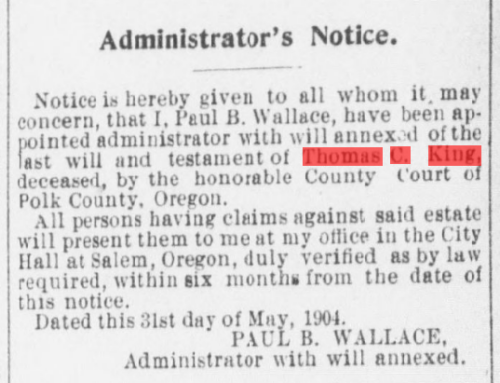
Leave A Comment